Accepting new private and Denplan patients
Very considerate of nervous patients
Spread the cost of your treatment with 0% finance
Highly trained team of cosmetic dentists
Wide range of treatment options
The latest cosmetic dental technology

Dental Implants
A dental implant is a surgical titanium post which is placed into the bone of the jaw to support a prosthetic replacement tooth. The implant acts like the root of the tooth, holding it securely in place and transferring biting force down into the jaw bone.
Modern dental implants are based on a biological process called osseointegration, where the bone securely attaches itself to the implant. This healing process usually takes 12 weeks, and the implant can thereafter be used to support a dental prosthesis such as a crown, bridge or denture.
Enquire Now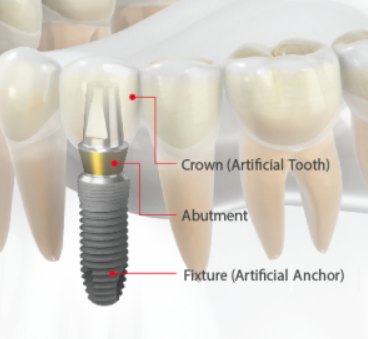
The fixture is a titanium device, which replaces the original root of the tooth and is embedded into the jaw. The fixture is accepted by the body and heals together with the bone tissue to act like a natural tooth root.
An abutment is a connective element used to attach the crown, bridge or denture to the dental implant fixture.
A crown is a custom-made prosthesis made specifically to resemble a natural tooth whilst fitting harmoniously with the adjacent teeth. This can be either a singular tooth or connected to other teeth in the form of a bridge or denture.
At Oaklands we only use Straumann or Implantium implants which are made from commercially pure grade 4 titanium. Titanium is non-toxic and compatible with the body. It has a wide range of medical uses and is a particularly successful in the field of medical joint replacements. Grade 4 titanium offers a large amount of strength and can last for decades. It is lightweight and it has been shown to bond well with adjacent bone during the healing process
The dental implant process requires a surgical procedure that is performed by one of our implant trained dentists at Oaklands Dental Surgery. It is a relatively painless procedure, usually done under local anaesthesia.
The first step to any dental implant procedure is diagnosis and treatment planning. Your dentist will perform a thorough evaluation of general and local health conditions, anatomical structure and treatment options. Once those are established, your dentist will offer the best recommendations for you.
Under local anaesthetic, your dentist will open the gum tissue where you are missing teeth. They will then place the implant fixture directly into the jaw bone. As this heals, the implant fixture will integrate with the bone and serve as a new root for a permanent tooth replacement.
Depending on your personal treatment plan, the implant is sometimes left buried during the healing process. Once the implant has integrated, the gums are reshaped to fit carefully around the prospective artificial tooth.
After the implant fixture has healed and integrated into the bone, impressions will be taken and an abutment (the component which connects the implant fixture to the crown) is chosen by your dentist. From the impressions taken, the laboratory can create a custom-made permanent restoration. It is designed and made to blend and fit well with the surrounding and adjacent teeth.
The custom made dental prosthesis is fitted in the mouth. The crown or bridge is placed on top of the abutment and functions as if it were your original tooth.
Aftercare and routine check-ups are required to ensure correct care and maintenance of the implant is being undertaken.
Replacement of a single tooth
For this procedure, an implant is placed to replace the root of the missing tooth, and then a custom-made prosthesis or crown is attached to replicate the actual tooth. The implant prevents bone loss by transmitting chewing forces through the jaw, and neighbouring teeth are generally not affected by the presence of the implant. Having an implant is widely regarded as much more cost effective than other options.
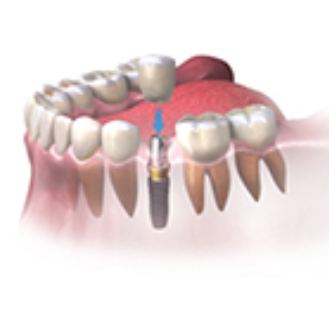 Appearance
Appearance
While the practical purpose of teeth is their most important aspect, teeth also play a huge role in our facial aesthetics. Prosthetics based on implants function just like natural teeth, both practically and aesthetically, returning your natural smile. This, of course, has a very positive impact on your self-confidence, self-esteem and overall mental health – A better life starts with a better smile!
Alternatives to single tooth implant replacement
The most common alternative treatment for a single missing tooth is the fitting of a bridge or denture.
Dentures are removable prostheses which replace either a full palate (all or most of the teeth) or partial palate (a few teeth or one tooth) that may fit with metal clasps that attach onto neighbouring teeth.
Bridges are permanently fixed prosthesis made of porcelain or ceramic bonded to metal, that replace either a small number of adjacent missing teeth or a single tooth. Bridges use one or both of their adjacent teeth as anchors.
The interference these prostheses have with other, sometimes healthy teeth is leading more and more people to opt for dental implants.
Advantages of single tooth implant replacement
Prosthesis based on dental implants are often more aesthetically pleasing than other treatment options as they help maintain the bone and therefore the overall shape of the face. As they are fixed in the mouth, the also dramatically improve functionality and long-term prognosis.
In the long run, many patients find that prosthesis based on implants are easier to clean and preserve than bridges and dentures, which can damage neighbouring teeth.
Due to the longevity of implants, they can not only help improve one’s quality of life, but they may also prove to be more financially cost effective than other possible treatments
Replacement of multiple teeth
What is an implant supported bridge?
A bridge is a non-removable prosthesis that replaces multiple lost teeth. Strategically placed implants can be used to support a multi-tooth prosthesis.
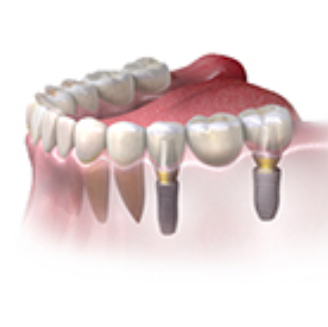 Appearance
Appearance
While the practical purpose of teeth is their most important aspect, teeth also play a huge role in our facial aesthetics. Prosthetics based on implants function just like natural teeth, both practically and aesthetically, returning your natural smile. This of course has a very positive impact on your self-confidence, self-esteem and overall mental health – A better life starts with a better smile!
An implant supported bridge not only affects the appearance of your mouth, but also your face in general. The forced exerted through the implants while chewing are the same as those through the roots of natural teeth, and this stimulation helps maintain the overall foundation of the jaw and, therefore, your facial structure.
Alternatives to Implant Supported Bridges
The most common alternative treatment for multiple missing teeth is the fitting of a denture. Dentures are removable prosthesis which replaces either a full palate (all or most of the teeth) or partial palate (a few teeth or one tooth) that may fit with metal clasps that attach onto neighbouring teeth. The interference these prostheses have with other, sometimes healthy teeth is leading more and more people to opt for dental implants.
Advantages of Implant Supported Bridges
Prosthesis based on dental implants are often more aesthetically pleasing than other treatment options as they help maintain the bone and therefore the overall shape of the face. As they are fixed in the mouth, the also dramatically improve functionality and long-term prognosis.
In the long run, many patients find that prosthesis based on implants are easier to clean and preserve than bridges and dentures, which can damage neighbouring teeth.
Due to the longevity of implants, they can not only help improve one’s quality of life, but they may also prove to be more financially cost effective than other possible treatments.
Replacement of a full set of teeth
What is an Implant Supported Denture
For this procedure, two or more implants are placed, which preserve the bone and provide long-lasting support for a denture. Said denture can either be permanently fixed or removable and in some cases, temporary dentures can be provided on the day of implant placement.
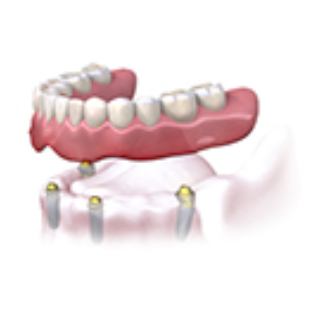 Alternatives to Implant Supported Dentures
Alternatives to Implant Supported Dentures
Traditional dentures are tailor-made to form-fit the gums and any remaining teeth, forming a friction or vacuum based seal which may be supported through the use of an adhesive. However, many patients find this style of dentures to be unstable and uncomfortable, and worry about eating, speaking and other daily activities. This is why implant supported dentures are preferable.
Advantages of Implant Supported Dentures
The major advantage of implant supported dentures is of course the increased stability, which restores proper chewing and can improve speech and comfort, with less irritation of the gums. Also, as the implants replicate the roots of teeth, the forces exerted while chewing maintain the structure of the jaw and aid the aesthetic of the entire face, not just the mouth. Also, in certain cases, an existing traditional denture can be adapted for use with implants.
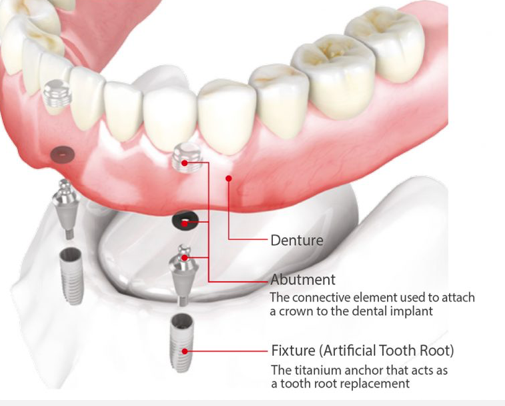 Fixed or Removable?
Fixed or Removable?
Implants allow for the denture to either be removable or permanently fixed. However, a fixed denture is not always an option, and in these cases a removable denture is required. Both varieties work on the same principle, but the removable denture varies in that it has popper-type attachments called positioners which can be ‘popped’ on and off the implants at the wearer’s discretion. Many patients actually prefer this option as their dentures are then easier to clean, but for many others permanently fixed dentures are preferable as they to them feel more like real teeth.
Dental implant treatment offers an almost equivalent restoration of missing teeth in terms of function, strength, and aesthetics. It recovers the natural beauty of your smile, promoting higher self-esteem and an improved lifestyle.
When teeth are lost, the bone and gums naturally recede, and over time this can change the shape of your face. Like natural teeth, dental implants transfer chewing forces to the jaw bone, which prevents bone resorption.

Prostheses based on implants are designed as a replacement for natural teeth, and as such are made to look realistic, allowing for a beautiful, comfortable smile.
Unlike other dental treatments that require extensive special care, an implant integrates with your body and, once healed, acts like a natural tooth root.
Implants can help you regain the quality of life that was lost with missing teeth. Laughing, speaking, kissing and eating, as you once did, can improve self-confidence without the ongoing discomfort that other treatment methods can yield.
Implants ensure a secure, comfortable fitting replacement to natural teeth that assists in proper chewing, allowing for a healthy and improved diet.
Implants provide a solution that doesn’t cause any damage to surrounding healthy teeth, unlike conventional bridgework.
Dental implants are a well-researched treatment option, which has shown extremely positive results. It has been used and studied worldwide for decades, and today is a safe, reliable and recommended treatment option.
Placement of dental implants is a surgical procedure and as such carries certain risks. Only a dental professional can evaluate whether you are suitable for implant treatment, and certain medical conditions might rule you out of implant treatment.
In some cases, restoration of your implant and smile can be done immediately. It is not always a quick fix and in some cases, the implant requires 4-12 weeks to integrate into the bone.
Studies (see Dentium Documentation Summaries) have shown that Implantium UK implants have a 97% success rate. Although, as with any medical procedure, there is always a slim chance it will not succeed
When you lose a tooth, your mouth may undergo the following changes
The jaw bone irreversibly changes if a tooth is lost or extracted and it not replaced with an implant. Without chewing pressure to stimulate the bone, it begins to dissolve away the bone – a process called resorption.
In addition to bone loss, there is also shifting of the adjacent teeth towards the vacant space. Over time, this will create gaps between the other teeth in other parts of the jaw.
When teeth are missing, the teeth on the opposing jaw have no counteracting force and will shift towards the vacant space. This will affect the general anatomical orientation of teeth and can limit what and how you can eat.
The deterioration of the jaw bone affects the appearance of the face. This can make one look older with more non-age related wrinkles, which can reduce confidence leading to a change in one’s lifestyle.
Dental implants can be used to prevent and/or reverse these changes.
Content taken with permission from implantium.co.uk